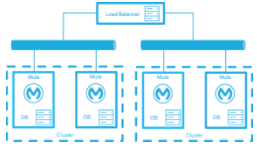High availability (HA) is a critical requirement for any modern IT system, including Mule, which is a leading integration platform for connecting applications, data, and devices in the enterprise. High availability ensures that a system remains operational and accessible even in the face of failures, minimizing downtime and maintaining business continuity. In this blog, we will explore four different HA options available with Mule to help organizations build robust and reliable integrations.
- Cold Standby
- Warm Standby
- Hot Standby – Active-Passive
- Active-Active
Cold Standby:
Cold Standby, also known as Passive Standby, is an HA architecture where a backup system is maintained in an inactive state, ready to take over in case the primary system fails. In Cold Standby, the backup system is not actively processing requests, and data synchronization between the primary and backup systems may not be real-time. The backup system is typically kept in a powered-off or idle state, and it requires manual intervention to activate and bring it online in case of a failure in the primary system.
Benefits of Cold Standby:
Cost-effective: Cold Standby is a relatively simple and cost-effective HA approach as it requires maintaining a backup system in an inactive state, which minimizes resource utilization and costs compared to active standby options.
Simplicity: Cold Standby is straightforward to implement and manage as it involves a separate backup system that remains inactive until needed. It doesn’t require complex data synchronization or automated failover mechanisms, making it easy to understand and operate.
Flexibility: Cold Standby provides flexibility in terms of choosing the right time to activate the backup system. It allows organizations to manually intervene and assess the situation before activating the backup system, which can be useful in certain scenarios where human judgment is required.
Downtime:
Some – The time it takes to start the environment and direct traffic.
Warm Standby
Warm Standby, also known as Semi-Active Standby, is an HA architecture that maintains a backup system that is partially active, with some services or components running and ready to take over in case of a failure in the primary system. Warm Standby strikes a balance between the simplicity of Cold Standby and the near-real-time data synchronization of Hot Standby.
Benefits of Warm Standby:
Faster Failover: Warm Standby provides faster failover compared to Cold Standby, as some services or components are already active and ready to take over in case of a failure. This results in reduced downtime and minimal impact on operations.
Near-Real-Time Data Synchronization: Warm Standby allows for more frequent data synchronization between the primary and backup systems compared to Cold Standby, which helps in reducing data loss and maintaining data consistency.
Flexibility: Warm Standby provides flexibility in terms of choosing the right time to activate the backup system. It allows organizations to automate the failover process or manually intervene and assess the situation before activating the backup system, depending on the specific requirements and limitations.
Downtime:
Little – The time it takes for the Mule Runtimes to start and to route traffic to the environment.
Hot Standby – Active-Passive
Hot Standby – Active-Passive is an HA architecture that maintains a fully active backup system that runs in parallel with the primary system, processing requests simultaneously. The backup system is actively engaged in processing requests and remains synchronized with the primary system in real-time. It is fully capable of taking over the entire workload of the primary system in case of a failure.
Benefits of Hot Standby – Active-Passive:
High Availability: Hot Standby – Active-Passive provides the highest level of availability compared to other HA architectures, as the backup system is fully active and capable of taking over the entire workload of the primary system in case of a failure. This ensures uninterrupted operations and minimal downtime.
Real-time Data Synchronization: Hot Standby – Active-Passive maintains real-time or near-real-time data synchronization between the primary and backup systems, ensuring that the backup system is always up-to-date with the latest data. This minimizes data loss and maintains data consistency.
Transparency to End-users: The failover process in Hot Standby – Active-Passive is typically transparent to the end-users, as the backup system takes over the workload without any manual intervention. This results in minimal disruption to end-users and ensures smooth operations.
Downtime:
Minimal to none – The time to route traffic to an environment.
Active-Active:
Active-Active architecture, also known as dual-active or multi-active architecture, is an HA approach that distributes the workload across multiple systems that are actively processing requests simultaneously. In an Active-Active setup, all systems are fully operational and capable of processing requests independently, resulting in a distributed and load-balanced workload across the systems.
Benefits of Active-Active Architecture:
Load Balancing: Active-Active architecture allows for distributing the workload across multiple systems, resulting in load balancing and optimized resource utilization. This can help to prevent resource bottlenecks and ensure efficient utilization of system resources.
High Scalability: Active-Active architecture can be easily scaled horizontally by adding more systems to the setup, allowing for increased capacity and performance as the workload grows. This makes it ideal for handling growing workloads and accommodating future growth.
Seamless Failover: Active-Active architecture provides seamless failover in case of a failure in one of the systems. As the workload is distributed across multiple systems, the remaining operational systems can continue to process requests without any manual intervention, ensuring uninterrupted operations.
Flexibility: Active-Active architecture provides flexibility in terms of system maintenance and upgrades, as the workload can be shifted dynamically from one system to another. This allows for performing maintenance or upgrades on one system while others continue to handle the workload.
Downtime:
None – There is no service downtime.




